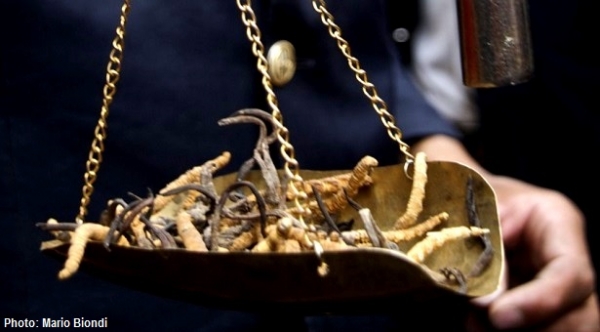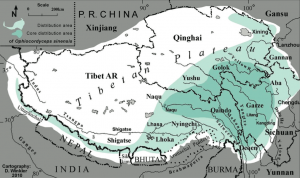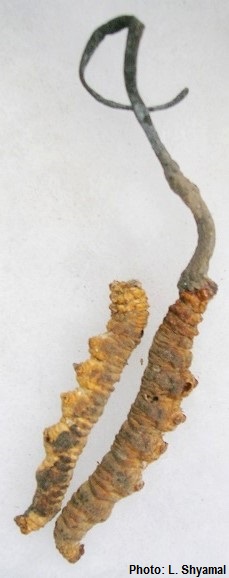Tibet’s prized parasitic fungus faces paradox of falling prices and shrinking harvests
Perhaps nowhere has traditional Chinese medicine done so much good for so many as in Tibet. Just not in a medical sense.
Every year around April, the brown-tipped stalks of Yartsa gunbu start to sprout from the countless corpses of golden ghost moth caterpillars barely buried in the topsoil of the Tibetan Plateau. As summer warmth creeps west, more stalks of this parasitic fungus, Ophiocordyceps sinensis, worm their way up from their host of dead hosts to the surface, whence they bulge and pop. So spreads another swarm of caterpillar-killing spores, beginning the process anew.
It’s the circle of life or would be, were the young stalks not quickly spotted by sharp eyed locals looking to turn a profit on centuries-old beliefs about these corpse-sprouts’ potent aphrodisiac powers. This despite little hard evidence to back up such claims, much less others ascribing miraculous healing powers to the caterpillar carcasses.
As elsewhere in China, the chief beneficiaries of traditional medicine in Tibet are often those peddling it; conversely, the biggest losers are the flora and fauna they harvest. For many native populations of Tibet and neighboring Qinghai, it is hard to overstate the economic import of Yartsa gunbu, often referred to in Mandarin as “worm-grass,” although it is neither. Indeed, demand has grown so great that harvests now pose a threat to the species’s survival.
Even so, this year has seen an ecologically welcome and economically unprecedented drop in the average price for these fungal bodies, down by about 28% from RMB125,000 (US$19,520) per batch just a few months ago, according to price figures published by Kangmei Pharmaceutical. Harvesting villages are now looking beyond short-term supply and demand, hoping to ensure future harvests through sustainability programs. But artificial cultivation could pose a far greater threat to worm-grass’s value in the long-term, as well as to the livelihoods of many on the Tibetan Plateau.
Daniel Winkler, author of much of the existing scholarship on worm-grass, has written that in Tibet, “caterpillar fungus income contribution is crucial for rural communities and its loss in rural areas would have a catastrophic impact.”
Historic value
The supposed bedroom potential of worm-grass was first recognized in the region during the 15th century by the author of a text titled “An Ocean of Aphrodisiacal Qualities”. Word had spread east by around the Tang dynasty as evidenced by a 1694 medical text, and it entered the records of Western civilization when a Jesuit priest serving as physician to the Qing emperor published a report on it in 1736, according to Winkler’s research (pdf).
Today the bug-fungus pair remains a largely East Asian commodity, where it is commonly held to help treat lung, kidney and liver problems, in addition to impotence and a host of other ailments. Most of the region’s demand comes from mainland China, where worm-grass’s value has received a boost from its supplemental role as a luxury good, gift and – as a matter of course – popular medium for bribery.
But the centuries-old annual harvest has increased in intensity; demand drove prices up 900% between 1997 and 2008, according to Winkler’s estimates. In mid-2008, average quality worm-grass sold for RMB30,000 (US$4,400) per 500 grams, while top quality sold for up to RMB80,000 (US$13,200) in Lhasa. Meanwhile in Shanghai, the same quality worm-grass fetched up to RMB160,000.
Since then the market has become more volatile while retaining a broadly upward trajectory. The market price for a batch of fungal caterpillars (3,500 “strips”) fell dramatically with the advent of the global financial crisis, from a peak of RMB100,100 in 2007 to a low of only RMB45,000 the following year, according to price history data from Kangmei Pharmaceutical.
That was followed by a sometimes shaky ascent that hit a plateau of RMB150,000 in late 2012. After dipping to a still-respectable RMB130,000 in 2013 prices remained fairly stable until this year’s harvest season got underway.
Parasites’ price
In an overview of worm-grass’s economic impact on Tibet, Winkler estimated that total annual income from the harvest stood at RMB1.8 billion in 2004, roughly 8.5% of the region’s gross domestic product and worth well more than the secondary sector of mining and industry (accounting for just RMB1.5 billion that year).
The harvest likely still accounts for a substantial amount of GDP in both Tibet and Qinghai: Even after prices’ recent plummet, a batch of worm-grass is still valued at about 300% of its year-end price in 2004.
Winkler also provides a rundown of the benefits worm-grass income brings to ordinary Tibetans: “Cash for health care, education, transportation—especially motorcycles—consumer goods and ‘spore’ money for entrepreneurial activities, such as trade as well as community activities. It also opened access to bank loans, which were next to impossible to obtain for rural Tibetans.”
As early as 2007 scholars were pointing out the increasingly unsustainable nature of the plateau’s annual harvests. A study published in the journal Biological Conservation in 2013 was among the first to quantify the damage anywhere in the Himalayan region.
By interviewing 203 harvesters and 28 traders in western Nepal, the study’s authors discovered annual trade had fallen from its 2009 peak by more than 50%. As a result, more time was spent finding fewer fungi, and the researchers found that about 94% of specimen collected hadn’t yet reached reproductive maturity—a presage to greater declines in annual yield.
At the time Liu Xingzhong, a mycologist in the Chinese Academy of Sciences’ Institute of Microbiology, told the journal Nature that there was “a similar trend in other Himalayan countries, such as China, India and Bhutan.” On the Tibetan Plateau, he said, the fungus yield for a given area had dropped 10-30% compared to a few decades prior.
Second cliff waiting
That decrease in supply is, at first blush, hard to square with this year’s plunging prices. As of the end of July, worm-grass’s value had fallen 41% from its May status quo, down to RMB90,000. But while such a fall is unprecedented, Liu told China Economic Review it was unlikely to mark the end of China’s fungal boom.
“The current drop is just a temporary fluctuation,” Liu said, noting a variety of factors had come together this year to drive prices down as never before.
First was an unexpected bumper harvest in Qinghai. Normally the region contributes less than Tibet to the national total, but this year Liu estimated it accounted for about 60% of production, leading to unexpectedly larger supplies.
Liu cited minor impact from artificial cultivation as another source of downward pressure. Farms like that of Dong Yangguang Group in Hubei are making substantial progress in cultivating the notoriously fickle fungus in factory farms, but Liu added that production from such farms had yet to enter the market (at least officially).
Liu also pointed to China’s economic slowdown as another drag on demand. That sentiment was echoed by a customer service representative for traditional Chinese medicine supplier Chun’an Tang, who noted that prices tended to go up every year before Chinese holidays like Spring Festival, but admitted they had dropped recently—likely due to the mainland’s slowing growth.
Last but far from least, Liu said the ongoing anticorruption drive was putting a damper on worm-grass’s side-gig as a wheel-greasing gift. With bribery subject to greater scrutiny, fewer officials were willing to give or receive it. But even the specter of detention likely can’t dent demand forever.
“If artificially cultivated worm-grass doesn’t enter the market, its market price shouldn’t be greatly affected,” Liu said. That may hold true for now, but pharmacy firms’ fungus farms could ultimately undo the scarcity that gives worm-grass such value. 500 grams of artificially cultivated Ophiocordyceps sinensis already runs for only around RMB30 (US$4.68) on sales platform Alibaba, though it’s provided sans-caterpillar.
That might provide eventual respite to the fungus’s population in the wild, though if China’s consumers can stand to part with Yartsa gunbu’s insectoid half, it could prove a huge blow for disadvantaged populations in Tibet and Qinghai whose incomes depend so heavily on the annual harvest. Some programs have already been initiated by harvesting communities to promote sustainable gathering practices, but whether or not they succeed, demand for the traditional cure could still drive an important sector of the regional economy right off the plateau’s far edge. ♦
Author: Hudson Lockett (@KangHexin)
Research: Xin Yuan (@yyyuanxin)
Source: www.chinaeconomicreview.com





comment 0